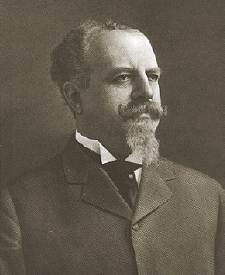|
American Beer Month
Beer barons
By Carl Miller
 Life inside a 19th-century American brewery required, at minimum, a hearty disposition. The work was arduous and the hours long. But, for many German immigrants, working in a brewery was a coveted privilege. Particularly within German-American enclaves, the local brewery was often the nucleus of its neighborhood. Lager beer, after all, was at the heart of daily life for many German immigrants, and its makers took great pride in producing the best they could. Brewmasters commanded unmatched respect, enjoying the status of virtual nobility. And the brewery owners -- with their great wealth and position in the community -- embodied the very success of the German people in America.
Life inside a 19th-century American brewery required, at minimum, a hearty disposition. The work was arduous and the hours long. But, for many German immigrants, working in a brewery was a coveted privilege. Particularly within German-American enclaves, the local brewery was often the nucleus of its neighborhood. Lager beer, after all, was at the heart of daily life for many German immigrants, and its makers took great pride in producing the best they could. Brewmasters commanded unmatched respect, enjoying the status of virtual nobility. And the brewery owners -- with their great wealth and position in the community -- embodied the very success of the German people in America.
Their prosperity was made possible by the more than four million Germans who departed their homeland for new life in America throughout the last half of the 19th century. Not surprisingly, the Germans' timeless affinity for beer was one of the few precious traditions not left behind in the great exodus. As droves of immigrants landed on American shores, beermaking entered a new era. Names like Busch, Pabst, Schlitz, Ruppert, Ehret and many others became synonymous with beer, and were soon destined to rank among the greatest names in all of American industry. Without question, the age of the "Beer Barons" had arrived.
The earliest of the German brewers in America brewed, by necessity, only top-fermented English style brews -- mainly ales and stouts. Not until the 1840s and 50s, with the arrival of bottom-fermenting lager beer yeast from Europe, could German brewers produce the Bavarian-style lagers and golden pilsners that would ultimately become their trademark in America. Reflecting on the long-anticipated arrival of lager beer in his town, one old immigrant commented, "To have lager beer from the tap in the land of hard liquor, what German friendly to drinking could not have felt the pull of home?"
And feel it they did. By the mid-1870s, the number of breweries operating in America had blossomed to an astounding 4,000. Over the next twenty-five years, the nation's beer production soared from about 10 million barrels (31 gallons per barrel) to nearly 40 million barrels per year. Brewery owners who once spent 18-hour days slaving over malt kilns and brew kettles now began to reap the rewards of their labor. As the never-ending stream of European immigration continued to flow, beermaking dynasties were being forged in virtually every city in the nation. Almost exclusively, Germans were at the helm.
 In St. Louis, Adolphus Busch was busy transforming his father-in-law's (Eberhard Anheuser's) once-failing brewery into a grand empire. Adolphus, perhaps more than any other brewer, became known for his flamboyant, almost audacious persona. Tirelessly promoting his Budweiser Beer, he toured the country in a luxurious railroad car immodestly named "The Adolphus." In place of the standard calling card, the young entrepreneur presented friends and business associates with his trademark gold-plated pocket knife featuring a peephole in which could be viewed a likeness of Adolphus himself. His workers bowed in deference as he passed. "See, just like der king!" he liked to say. In St. Louis, Adolphus Busch was busy transforming his father-in-law's (Eberhard Anheuser's) once-failing brewery into a grand empire. Adolphus, perhaps more than any other brewer, became known for his flamboyant, almost audacious persona. Tirelessly promoting his Budweiser Beer, he toured the country in a luxurious railroad car immodestly named "The Adolphus." In place of the standard calling card, the young entrepreneur presented friends and business associates with his trademark gold-plated pocket knife featuring a peephole in which could be viewed a likeness of Adolphus himself. His workers bowed in deference as he passed. "See, just like der king!" he liked to say.
In New York City, brewery owner George Ehret enjoyed a similar majesty. Affectionately nicknamed "the crazy Dutchman" despite his German birth, Ehret was the quintessential beer baron. Within a mere dozen years after its founding in 1866, Ehret's Hell Gate Brewery (named for the neighborhood in which it was located) was producing more beer than any other brewery in the country. Investing much of his profit in real estate, the crazy Dutchman ultimately ranked near the infamous Astors in the value of his property holdings in the city.
However, it was Ehret's competitors, brewer Jacob Ruppert, who won the hearts of New Yorkers. Colonel Ruppert, as he was known, bought the New York Yankees in 1915 and transformed the struggling baseball team into the American League powerhouse of their day. Using his vast beer profits, the Colonel built Yankee Stadium and bought talent like Babe Ruth and Waite Hoyt. During the twenty-four years the Colonel owned the team, the Yankees won seven World Championships and boasted some of history's greatest players.
Of course, there were no beer barons like those of Milwaukee -- the city virtually built on malt and hops. The unmatched quantities of beer consumed in the brew city during the 19th century gave rise to the popular term "Milwaukee goiter," used to refer to a rounded belly. A well-known joke of the day said that every kitchen sink in Milwaukee had three faucets -- one for hot water, one for cold water, and the biggest for beer.
Captain Frederick Pabst can perhaps claim the lion's share of credit for Milwaukee's status as a world-renown brewing center. In 1893, the Captain became the first brewer in America to sell more than one million barrels of beer in a single year. (Though the majority was packaged in wood kegs, the brewery used 300,000 yards of blue ribbon each year to tie around the bottle necks of its popular Pabst Select brand. The name, of course, was later changed to Pabst Blue Ribbon.)
To the countless German-American immigrants of the late-19th century, lager beer meant something far different than the wealth and success the beer barons enjoyed. Lager beer was, perhaps more than anything else, a social icon. It represented family, friends, and German camaraderie. And nowhere was this more true than at the local beer garden. A weekend resort laid out amidst shady trees and sprawling lawns, the typical beer garden was manicured to be the perfect setting for that most important of 19th century pastimes: quaffing the amber fluid. After all, the beer garden provided something which most immigrant-Americans could not get anywhere else -- something the Germans called gemutlichkeit.
But the typical beer garden offered far more than just beer and gemutlichkeit. There was music, dancing, sport and leisure. It was an occasion for the whole family, and one which usually lasted the entire day, from sunup to sundown. Indeed, for the mostly working class throngs who came, the beer garden was an oasis in an otherwise workaday life. As such, it played an important role in the lives of countless immigrants.
Milwaukee, of course, was the undisputed leader in the number (and extravagance) of beer gardens. Competition between the city's dozens of gardens was fierce, and all manner of entertainment was employed to lure a large beer-drinking crowd. Lueddemann's Garden, for example, once featured a "daring and beautiful" female performer who set fire to herself and plunged 40 feet into the river below, much to the delight of on-lookers.
However, those gardens which were owned by the beer barons themselves featured the most popular attractions. In 1879, the Schlitz brewery bought a local beer garden and turned it into a magnificent resort, appropriately renamed Schlitz Park. The large garden was a virtual entertainment mecca, featuring a concert pavilion, a dance hall, a bowling alley, refreshment parlors, and live performers such as tightrope walkers and other circus-style entertainers. In the center of the park was a hill topped by a three-story pagoda-like structure which offered a panoramic view of the city. At night, the garden was dramatically illuminated by the 250 gas globes which lined the terrace of the central hill. The park was a popular spot for political gatherings. Among those who made speeches at Schlitz Park over the years were Grover Cleveland, William McKinley, Theodore Roosevelt and William Jennings Bryan.
Not to be outdone by his hometown rival, Captain Pabst operated Pabst Park in Milwaukee (among other beer gardens). The eight-acre resort boasted a 15,000-foot-long roller coaster, a "Katzenjammer palace" fun house, and an oddity touted as "the smallest real railroad in the world." Wild west shows were held on a regular basis, and live orchestras performed seven days a week all through summer. Of course, whatever the attraction, a 5� schooner of cold Pabst Beer was never far from reach.
This is an excerpt from "The Rise of the Beer Barons" at The American Brewery History Page. Stop by to read the whole story plus many more about the role beer has played in American life for more than 400 years.
|

